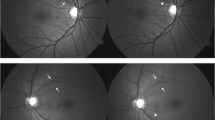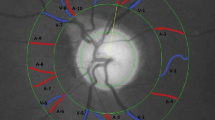Abstract
Purpose
To investigate retinal vessel diameter in patients classified as bilateral glaucoma suspects who showed unilateral glaucomatous conversion.
Methods
This retrospective study included 21 patients who had initially been diagnosed as bilateral glaucoma suspects but showed unilateral glaucomatous conversion during a follow-up period of more than 2 years. Conversion to glaucoma was determined either by documentation of a new retinal nerve fiber layer defect on red-free photography or a reproducible glaucomatous visual field defect. The central retinal arteriolar equivalent (CRAE) and central retinal venular equivalent (CRVE) were measured from fundus photographs taken at baseline and at the point of glaucoma conversion.
Results
The mean CRAE of the converted eyes was significantly lower than that of the non-converted eyes at baseline (164.9 ± 13.2 μm vs 175.2 ± 15.6 μm; p = 0.001), but no significant difference was observed in the mean CRVE (p = 0.108). The mean CRAE of the converted eyes was also lower than in the non-converted eyes at the point of glaucoma conversion (158.6 ± 13.5 μm vs 168.0 ± 17.2 μm; p = 0.011).
Conclusion
In bilateral glaucoma suspects, there was a significant inter-eye difference in CRAE at baseline between eyes that converted to glaucoma and those that did not. These findings suggest that measurement of retinal arteriolar diameter may help clinicians when evaluating the risk of conversion in glaucoma suspects.


Similar content being viewed by others
References
Kingman S (2004) Glaucoma is second leading cause of blindness globally. Bull World Health Organ 82:887–888. doi:10.1590/S0042-96862004001100019
Keltner JL, Johnson CA, Anderson DR et al (2006) The association between glaucomatous visual fields and optic nerve head features in the Ocular Hypertension Treatment study. Ophthalmology 113:1603–1612. doi:10.1016/j.ophtha.2006.05.061
Tielsch JM, Katz J, Quigley HA et al (1988) Intraobserver and interobserver agreement in measurement of optic disc characteristics. Ophthalmology 95:350–356
Budenz DL, Fredette MJ, Feuer WJ, Anderson DR (2008) Reproducibility of peripapillary retinal nerve fiber thickness measurements with stratus OCT in glaucomatous eyes. Ophthalmology 115:661.e4–666.e4. doi:10.1016/j.ophtha.2007.05.035
Iverson SM, Feuer WJ, Shi W, Greenfield DS (2014) Frequency of abnormal retinal nerve fibre layer and ganglion cell layer SDOCT scans in healthy eyes and glaucoma suspects in a prospective longitudinal study. Br J Ophthalmol 98:920–925. doi:10.1136/bjophthalmol-2013-303877
Hermann MM, Garway-Heath DF, Jonescu-Cuypers CP, Burk RO, Jonas JB, Mardin CY, Funk J, Diestelhorst M (2005) Interobserver variability in confocal optic nerve analysis (HRT). Int Ophthalmol 26:143–149. doi:10.1007/s10792-006-9022-9
Da Pozzo S, Fuser M, Vattovani O, Di Stefano G, Ravalico G (2006) GDx-VCC performance in discriminating normal from glaucomatous eyes with early visual field loss. Graefes Arch Clin Exp Ophthalmol 244:689–695. doi:10.1007/s00417-005-0144-y
Leung CK, Cheung CY, Weinreb RN, Qiu K, Liu S, Li H, Xu G, Fan N, Pang CP, Tse KK, Lam DS (2010) Evaluation of retinal nerve fiber layer progression in glaucoma: a study on optical coherence tomography guided progression analysis. Invest Ophthalmol Vis Sci 51:217–222. doi:10.1167/iovs.09-3468
Bowd C, Balasubramanian M, Weinreb RN, Vizzeri G, Alencar LM, O’Leary N, Sample PA, Zangwill LM (2009) Performance of confocal scanning laser tomograph topographic change analysis (TCA) for assessing glaucomatous progression. Invest Ophthalmol Vis Sci 50:691–701. doi:10.1167/iovs.08-2136
Grewal DS, Sehi M, Greenfield DS (2011) Detecting glaucomatous progression using GDx with variable and enhanced corneal compensation using guided progression analysis. Br J Ophthalmol 95:502–508. doi:10.1136/bjo.2010.180810
Burr JM, Mowatt G, Hernandez R, Siddiqui MA, Cook J, Lourenco T, Ramsay C, Vale L, Fraser C, Azuara-Blanco A, Deeks J, Cairns J, Wormald R, McPherson S, Rabindranath K, Grant A (2007) The clinical effectiveness and cost-effectiveness of screening for open angle glaucoma: a systematic review and economic evaluation. Health Technol Assess 11(41): iii–iv, ix–x, 1–190
Amerasinghe N, Aung T, Cheung N, Fong CW, Wang JJ, Mitchell P, Saw SM, Wong TY (2008) Evidence of retinal vascular narrowing in glaucomatous eyes in an Asian population. Invest Ophthalmol Vis Sci 49:5397–5402. doi:10.1167/iovs.08-2142
Mitchell P, Leung H, Wang JJ, Rochtchina E, Lee AJ, Wong TY, Klein R (2005) Retinal vessel diameter and open-angle glaucoma: the Blue Mountains Eye study. Ophthalmology 112:245–250. doi:10.1016/j.ophtha.2004.08.015
Wang S, Xu L, Wang Y, Wang Y, Jonas JB (2007) Retinal vessel diameter in normal and glaucomatous eyes: the Beijing eye study. Clin Experiment Ophthalmol 35:800–807. doi:10.1111/j.1442-9071.2007.01627.x
Patton N, Maini R, MacGillivary T, Aslam TM, Deary IJ, Dhillon B (2005) Effect of axial length on retinal vascular network geometry. Am J Ophthalmol 140:648–653. doi:10.1016/j.ajo.2005.04.040
Kass MA, Heuer DK, Higginbotham EJ, Johnson CA, Keltner JL, Miller JP, Parrish RK, 2nd, Wilson MR, Gordon MO (2002) The Ocular Hypertension Treatment Study: a randomized trial determines that topical ocular hypotensive medication delays or prevents the onset of primary open-angle glaucoma. Arch Ophthalmol 120(6):701–713, discussion 829–730
Anderson DR, Patella VM (1999) Automated static perimetry, 2nd edn. Mosby, St. Louis, pp 121–190
Berger JW, Patel TR, Shin DS, Piltz JR, Stone RA (2000) Computerized stereochronoscopy and alternation flicker to detect optic nerve head contour change. Ophthalmology 107:1316–1320
Lee TE, Kim YY, Yoo C (2014) Retinal vessel diameter in normal-tension glaucoma patients with asymmetric progression. Graefes Arch Clin Exp Ophthalmol 252:1795–1801. doi:10.1007/s00417-014-2756-6
Knudtson MD, Lee KE, Hubbard LD, Wong TY, Klein R, Klein BE (2003) Revised formulas for summarizing retinal vessel diameters. Curr Eye Res 27:143–149
Hwang YH, Ahn SI, Ko SJ (2015) Diagnostic ability of macular ganglion cell asymmetry for glaucoma. Clin Experiment Ophthalmol 43:720–726. doi:10.1111/ceo.12545
Yamada H, Hangai M, Nakano N, Takayama K, Kimura Y, Miyake M, Akagi T, Ikeda HO, Noma H, Yoshimura N (2014) Asymmetry analysis of macular inner retinal layers for glaucoma diagnosis. Am J Ophthalmol 158:1318.e3–1329.e3. doi:10.1016/j.ajo.2014.08.040
Garhofer G, Werkmeister R, Dragostinoff N, Schmetterer L (2012) Retinal blood flow in healthy young subjects. Invest Ophthalmol Vis Sci 53:698–703. doi:10.1167/iovs.11-8624
Riva CE, Grunwald JE, Sinclair SH, Petrig BL (1985) Blood velocity and volumetric flow rate in human retinal vessels. Invest Ophthalmol Vis Sci 26:1124–1132
Kim JM, Sae Kim M, Ju Jang H, Ho Park K, Caprioli J (2012) The association between retinal vessel diameter and retinal nerve fiber layer thickness in asymmetric normal tension glaucoma patients. Invest Ophthalmol Vis Sci 53:5609–5614. doi:10.1167/iovs.12-9783
Kawasaki R, Wang JJ, Rochtchina E, Lee AJ, Wong TY, Mitchell P (2013) Retinal vessel caliber is associated with the 10-year incidence of glaucoma: the Blue Mountains Eye Study. Ophthalmology 120:84–90. doi:10.1016/j.ophtha.2012.07.007
Piltz-seymour JR, Grunwald JE, Hariprasad SM, Dupont J (2001) Optic nerve blood flow is diminished in eyes of primary open-angle glaucoma suspects. Am J Ophthalmol 132:63–69
Calvo P, Ferreras A, Polo V, Guerri N, Seral P, Fuertes-Lazaro I, Pablo LE (2012) Predictive value of retrobulbar blood flow velocities in glaucoma suspects. Invest Ophthalmol Vis Sci 53:3875–3884. doi:10.1167/iovs.11-8817
Yoo E, Yoo C, Lee BR, Lee TE, Kim YY (2015) Diagnostic ability of retinal vessel diameter measurements in open-angle glaucoma. Invest Ophthalmol Vis Sci 56:7915–7922. doi:10.1167/iovs.15-18087
Wong TY, Knudtson MD, Klein R, Klein BE, Meuer SM, Hubbard LD (2004) Computer-assisted measurement of retinal vessel diameters in the Beaver Dam Eye Study: methodology, correlation between eyes, and effect of refractive errors. Ophthalmology 111:1183–1190. doi:10.1016/j.ophtha.2003.09.039
Polo V, Larrosa JM, Pinilla I, Perez S, Gonzalvo F, Honrubia FM (2002) Predictive value of short-wavelength automated perimetry: a 3-year follow-up study. Ophthalmology 109:761–765
Medeiros FA, Sample PA, Weinreb RN (2004) Frequency doubling technology perimetry abnormalities as predictors of glaucomatous visual field loss. Am J Ophthalmol 137:863–871. doi:10.1016/j.ajo.2003.12.009
Mwanza JC, Durbin MK, Budenz DL, Sayyad FE, Chang RT, Neelakantan A, Godfrey DG, Carter R, Crandall AS (2012) Glaucoma diagnostic accuracy of ganglion cell-inner plexiform layer thickness: comparison with nerve fiber layer and optic nerve head. Ophthalmology 119:1151–1158. doi:10.1016/j.ophtha.2011.12.014
Sherry LM, Wang JJ, Rochtchina E, Wong T, Klein R, Hubbard L, Mitchell P (2002) Reliability of computer-assisted retinal vessel measurement in a population. Clin Experiment Ophthalmol 30:179–182
Sharrett AR, Hubbard LD, Cooper LS, Sorlie PD, Brothers RJ, Nieto FJ, Pinsky JL, Klein R (1999) Retinal arteriolar diameters and elevated blood pressure: the atherosclerosis risk in communities study. Am J Epidemiol 150:263–270
Klein R, Myers CE, Knudtson MD, Lee KE, Gangnon R, Wong TY, Klein BE (2012) Relationship of blood pressure and other factors to serial retinal arteriolar diameter measurements over time: the Beaver Dam Eye Study. Arch Ophthalmol 130:1019–1027. doi:10.1001/archophthalmol.2012.560
Liew G, Mitchell P, Leeder SR, Smith W, Wong TY, Wang JJ (2006) Regular aspirin use and retinal microvascular signs: the Blue Mountains Eye Study. J Hypertens 24:1329–1335. doi:10.1097/01.hjh.0000234113.33025.33
Howard KP, Klein BE, Dreyer JO, Danforth LG, Klein R (2014) Cross-sectional associations of medication and supplement use with retinal vascular diameter in the Beaver Dam Eye Study. JAMA Ophthalmol 132:23–31. doi:10.1001/jamaophthalmol.2013.6326
Liao D, Wong TY, Klein R, Jones D, Hubbard L, Sharrett AR (2004) Relationship between carotid artery stiffness and retinal arteriolar narrowing in healthy middle-aged persons. Stroke 35:837–842. doi:10.1161/01.str.0000120310.43457.ad
Jeganathan VS, Sabanayagam C, Tai ES, Lee J, Lamoureux E, Sun C, Kawasaki R, Wong TY (2009) Retinal vascular caliber and diabetes in a multiethnic Asian population. Microcirculation 16:534–543. doi:10.1080/10739680902975222
Kifley A, Wang JJ, Cugati S, Wong TY, Mitchell P (2008) Retinal vascular caliber and the long-term risk of diabetes and impaired fasting glucose: the Blue Mountains Eye study. Microcirculation 15:373–377. doi:10.1080/10739680701812220
Hao H, Sasongko MB, Wong TY, Che Azemin MZ, Aliahmad B, Hodgson L, Kawasaki R, Cheung CY, Wang JJ, Kumar DK (2012) Does retinal vascular geometry vary with cardiac cycle? Invest Ophthalmol Vis Sci 53:5799–5805. doi:10.1167/iovs.11-9326
Lisboa R, Leite MT, Zangwill LM, Tafreshi A, Weinreb RN, Medeiros FA (2012) Diagnosing preperimetric glaucoma with spectral domain optical coherence tomography. Ophthalmology 119:2261–2269. doi:10.1016/j.ophtha.2012.06.009
Lalezary M, Medeiros FA, Weinreb RN, Bowd C, Sample PA, Tavares IM, Tafreshi A, Zangwill LM (2006) Baseline optical coherence tomography predicts the development of glaucomatous change in glaucoma suspects. Am J Ophthalmol 142:576–582. doi:10.1016/j.ajo.2006.05.004
Acknowledgments
The authors thank Dr. Nicola Ferrier (University of Wisconsin, Madison School of Engineering and the Fundus Photograph Reading Center, Department of Ophthalmology and Visual Sciences, University of Wisconsin, Madison) for granting permission to use the IVAN software.
Author information
Authors and Affiliations
Corresponding author
Ethics declarations
Funding
No funding was received for this research.
Conflict of interest
None of the authors have any affiliations with or involvement in any organization or entity with any financial interest (such as honoraria; educational grants; participation in speakers’ bureaus; membership, employment, consultancies, stock ownership, or other equity interest; and expert testimony or patent-licensing arrangements), or nonfinancial interest (such as personal or professional relationships, affiliations, knowledge, or beliefs) in the subject matter or materials discussed in this manuscript.
Ethical approval
All procedures performed in studies involving human participants were in accordance with the ethical standards of the institutional and/or national research committee and with the 1964 Helsinki Declaration and its later amendments or comparable ethical standards. For this type of study formal consent is not required.
Rights and permissions
About this article
Cite this article
Yoo, E., Yoo, C., Lee, TE. et al. Retinal vessel diameter in bilateral glaucoma suspects: comparison between the eye converted to glaucoma and the contralateral non-converted eye. Graefes Arch Clin Exp Ophthalmol 254, 1599–1608 (2016). https://doi.org/10.1007/s00417-016-3392-0
Received:
Revised:
Accepted:
Published:
Issue Date:
DOI: https://doi.org/10.1007/s00417-016-3392-0




